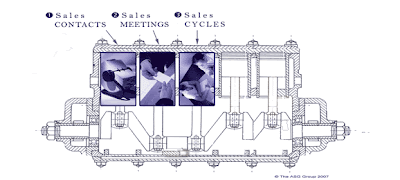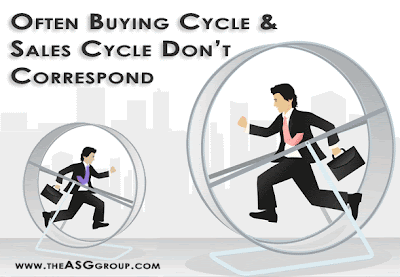A cycle is defined as 'a series of events that are regularly repeated in the same order'. Thus the term fits well with the modern world of buying and selling, with buyer and seller increasingly adopting a structured and systematic approach to their work. In this article we discuss the many reasons why we have used the term cycle as part of the sales and marketing engine (shown below).

Don’t miss the cycle. If you go straight from sales meeting to sales proposal, you miss a vital step. That is the essential step where you confirm, clarify and shape needs, establish the requirements of stakeholders, explore solutions and gain a shared commitment to take action. It is where you sell your solution, people and processes.
Don’t sell too early, because:
· Selling in initial sales meetings or in cold calls is ineffective. Buyers don’t like it. You have to use a more effective means of getting their attention. Simply delivering your traditional, feature led, sales pitch will not work.
· A proposal written without sufficient interaction with the prospect runs the risk of failing to accurately understand needs, or to build ownership of the solution among the prospect.
· You cannot sell until you know what is required. Even if you already know, you cannot sell until you show you are interested.
· You cannot fast track the buying decision, or the building of a relationship.
Buying decisions are complex, indeed increasingly so. Cycles connotates this well. There are many people involved in the buying decision, multiple stakeholders, complex requirements (some of which may be conflicting), competing priorities and projects.
Buying cycles do not necessary correspond with sales cycles. Buyers call sales people to the table later and later, often after requirements have been determined and the business case created. To avoid this sellers have to look beyond those who have a need and a budget, that means selling to satisfied.
Buyers don’t just arrive at decisions; they go through a process of decision making. We look at organisations who are at 3 stages:
· Recognition of need
· Search for solution
· Selection of supplier
The salespeople must think in terms of the buying cycle. The sales approach should vary depending on the stage the buyer is at. The sales approach has to blend each stage. For example, if a prospect is looking for training it is beneficial to look beyond that solution to the need – that is what the training is expected to achieve. This examination may enable the ideal training solution to be defined, or indeed enable looking beyond training to other solutions.
A structured sales process is important. We wanted a term that related to a sales process, as well as buying process. This is important for two reasons firstly it helps with pipeline visibility, predictability and control. Secondly it helps to determine if an opportunity has proceeded though the standard steps of the sales process, for example;
· needs analysis across all stakeholders,
· defining buying requirements,
· covering the buying unit,
· prequalification of the opportunity (in terms of budget, timing, etc.).
Selling is complex. We wanted a term that recognized that sales process is not a straight line. The salesperson may at certain times feel like good progress is being made, while at other times he or she may feel that the deal is getting further away, as opposed to closer.

Buyer trumps seller, every time. We wanted to focus attention on buying process, as opposed to sales process – but not just about trying to corral the buyer into a process that suits the sales organization. Indeed, often the seller is not at the centre of the buying process.
Avoiding confusion. We could have called this cylinder opportunities, or prospects. Here is why we didn’t:
· Both terms are hard to define and can be highly subjective
· Both terms tend to suggest that you can go straight into a pipeline forecast after a meeting or two
· we wanted a term that was buyer – seller neutral –that is relevant to either side
Your work is never done, until the decision is made the salesperson must continue to build the relationship, understand the needs and so on. If the seller stops then he may be leaving the way open for a competitor.
The sale is not the end. The cycle in a way, has no beginning and no end. The relationship is more important than the order, or the transaction. Even if vendor does not win one order, it does not mean that the relationship should not be maintained. The lifetime value of the relationship is what is important. Suppliers disappoint their customers all the time, so by maintaining the relationship, in spite of not winning the order, the salesperson can ensure that he, or she is in pole position for the next purchase.
Both sides now! We also like the term cycle because it fits well with what we call 360 degree selling –where the salesperson is able to make a 360 degree wing from the sellers side of the table to the buyers side of the table and back again - thereby facilitating a better understanding of the buyer’s requirements and capable of adopting the position of trusted advisor. This is also reflective of a bi-lateral approach to the sale, where buyer and seller engage in a joint process of exploration and problem solving. This is particularly important in an environment where buyers are increasingly keeping salespeople at arm’s length.
Bi-Cycle or uni-cycle. We like to think of cycles (either buyer, or seller) as being two types, that is; bi cycle, or uni cycle. The later involves the salesperson, or buyer alone, while the former involves both in equal partnership. Two wheels are better than one - it is what others have called Joint Venture selling, or a bi-partisan approach.
For an overview of the sales engine and its role in setting sales and marketing priorities click here.




No comments:
Post a Comment